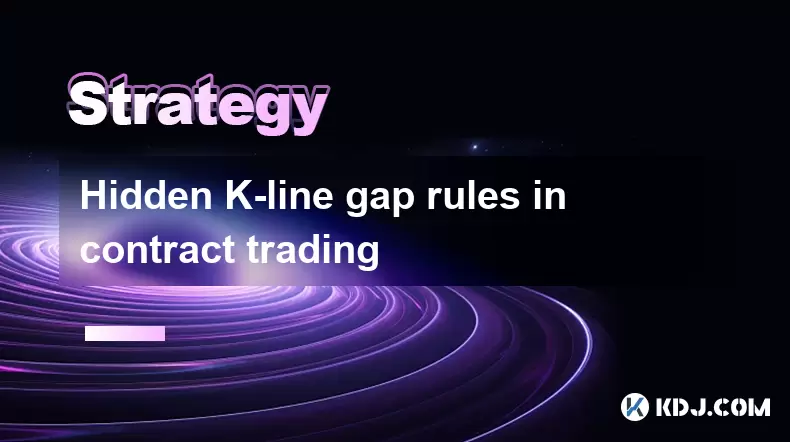-
 bitcoin
bitcoin $112195.049338 USD
2.42% -
 ethereum
ethereum $4124.915858 USD
2.81% -
 tether
tether $1.000570 USD
0.02% -
 xrp
xrp $2.861568 USD
2.25% -
 bnb
bnb $1000.346670 USD
3.04% -
 solana
solana $209.070819 USD
3.38% -
 usd-coin
usd-coin $0.999870 USD
0.02% -
 dogecoin
dogecoin $0.235379 USD
2.65% -
 tron
tron $0.335681 USD
-0.20% -
 cardano
cardano $0.803501 USD
3.38% -
 hyperliquid
hyperliquid $47.120881 USD
3.56% -
 chainlink
chainlink $21.501300 USD
3.44% -
 ethena-usde
ethena-usde $1.000571 USD
0.02% -
 avalanche
avalanche $29.793378 USD
3.62% -
 stellar
stellar $0.366964 USD
2.42%
Hidden K-line gap rules in contract trading
Hidden K-line gaps, often overlooked, can signal market reversals or continuations, enhancing trading strategies in volatile crypto markets.
Jun 04, 2025 at 06:43 am

Hidden K-line gaps in contract trading are a phenomenon that many traders might overlook, yet understanding these gaps can significantly enhance a trader's strategy. Hidden K-line gaps refer to price levels where trading activity is minimal or nonexistent, creating a gap in the price chart that is not immediately visible. These gaps can occur in both bullish and bearish trends and are critical because they often signal potential reversals or continuations in the market. In the context of cryptocurrency trading, where volatility is high, recognizing and understanding these hidden gaps can provide traders with a competitive edge.
Identifying Hidden K-line Gaps
To effectively identify hidden K-line gaps, traders need to closely analyze their price charts. Hidden gaps can be spotted by looking for areas where the price jumps from one level to another without any trading activity in between. These gaps can be small or large, depending on the timeframe and the market's liquidity at the time of the gap. In cryptocurrency trading, these gaps often appear after significant news events or during periods of low liquidity, such as weekends or holidays. Traders should use high-quality charting tools that allow for detailed zoom-ins and the ability to view different time frames to spot these subtle gaps.
Types of Hidden K-line Gaps
There are several types of hidden K-line gaps that traders should be aware of. Breakout gaps occur when the price breaks out of a consolidation phase and jumps to a new level. These gaps often signal the start of a new trend. Exhaustion gaps appear at the end of a trend and indicate that the current trend is running out of steam. Continuation gaps happen within a trend and suggest that the trend will continue. Each type of gap has different implications for trading strategies, and understanding these can help traders make more informed decisions.
Trading Strategies Based on Hidden K-line Gaps
Developing a trading strategy around hidden K-line gaps requires careful analysis and planning. For breakout gaps, traders might consider entering a position in the direction of the gap, anticipating a continuation of the new trend. When encountering an exhaustion gap, traders could look for signs of a reversal and consider taking profits or entering a counter-trend position. Continuation gaps might prompt traders to add to their existing positions, expecting the trend to persist. It's essential for traders to use other technical indicators and market analysis to confirm their strategies, as relying solely on gaps can be risky.
Risk Management and Hidden K-line Gaps
Effective risk management is crucial when trading based on hidden K-line gaps. Setting stop-loss orders is a fundamental practice to limit potential losses. Traders should place stop-loss orders just beyond the gap, as these levels can act as support or resistance. Additionally, position sizing is important; traders should not risk more than a small percentage of their total capital on any single trade. Using trailing stops can help lock in profits as the price moves in the trader's favor. By combining these risk management techniques with a well-thought-out trading strategy, traders can navigate the volatility of cryptocurrency markets more effectively.
Tools and Indicators for Analyzing Hidden K-line Gaps
Several tools and indicators can assist traders in analyzing hidden K-line gaps. Volume indicators are particularly useful, as they can show whether a gap is supported by significant trading volume, which adds credibility to the gap's significance. Moving averages can help traders identify trends and potential reversal points. Fibonacci retracement levels can be used to identify potential support and resistance levels where hidden gaps might occur. Additionally, candlestick patterns can provide further confirmation of the market's direction after a gap appears. By combining these tools, traders can gain a more comprehensive view of the market and make better-informed trading decisions.
Practical Example of Trading with Hidden K-line Gaps
To illustrate how hidden K-line gaps can be used in trading, consider the following example. Suppose a trader notices a breakout gap on the daily chart of Bitcoin, where the price jumps from $40,000 to $42,000 without any trading activity in between. The trader might decide to enter a long position at $42,000, anticipating that the new trend will continue. The trader sets a stop-loss order at $41,800, just below the gap, to limit potential losses. As the price moves in favor of the trader, reaching $43,000, the trader adjusts the stop-loss to $42,800 using a trailing stop. If the price continues to rise, the trader can continue to adjust the stop-loss to lock in profits.
Frequently Asked Questions
Q: Can hidden K-line gaps be used in all timeframes?A: Yes, hidden K-line gaps can be observed in various timeframes, from intraday charts to weekly and monthly charts. However, the significance and trading implications of these gaps may vary depending on the timeframe. Shorter timeframes might show more frequent but smaller gaps, while longer timeframes could reveal larger, more significant gaps.
Q: How do hidden K-line gaps differ from regular price gaps?A: Hidden K-line gaps are less visible and occur where there is minimal or no trading activity, often requiring closer inspection of the chart. Regular price gaps, on the other hand, are more apparent and occur when the price moves from the close of one period to the open of the next without any trading in between. Both types of gaps can be significant, but hidden gaps require more detailed analysis.
Q: Are hidden K-line gaps more common in certain cryptocurrencies?A: Hidden K-line gaps can occur in any cryptocurrency, but they might be more common in less liquid markets or during times of low trading volume. Cryptocurrencies with higher liquidity, such as Bitcoin and Ethereum, may exhibit fewer hidden gaps due to more consistent trading activity. However, even in these markets, hidden gaps can still occur, particularly after significant news events or during off-peak trading hours.
Q: Can hidden K-line gaps be used for both long and short positions?A: Yes, hidden K-line gaps can be used to inform both long and short positions. For instance, a breakout gap might suggest entering a long position, while an exhaustion gap could signal a potential short position if a reversal is anticipated. Traders should always use additional analysis and risk management techniques to validate their trading decisions based on these gaps.
Disclaimer:info@kdj.com
The information provided is not trading advice. kdj.com does not assume any responsibility for any investments made based on the information provided in this article. Cryptocurrencies are highly volatile and it is highly recommended that you invest with caution after thorough research!
If you believe that the content used on this website infringes your copyright, please contact us immediately (info@kdj.com) and we will delete it promptly.
- Bitcoin, Ethereum, and Correction Concerns: Navigating the Crypto Seas
- 2025-09-30 08:25:12
- SWIFT, Consensys, and Blockchain Settlement: A New Era for Global Finance?
- 2025-09-30 06:25:13
- Andre Cronje's Flying Tulip Takes Flight with $200M Round: A New Era for DeFi?
- 2025-09-30 06:45:14
- SEC, CFTC, and Crypto Rumors: Harmonization Efforts and ETF Developments
- 2025-09-30 06:45:14
- Gold Dollar Coin, Mystery, Upright 5: Unearthing Hidden History and Whale-Sized Speculation
- 2025-09-30 06:25:13
- Meme Coins, Smart Money, 2025 Riches: Navigating the Hype
- 2025-09-30 06:30:01
Related knowledge

Practical parameter settings for a Bitcoin multi-timeframe moving average system
Sep 18,2025 at 10:54pm
Optimizing Timeframe Combinations for Bitcoin Trading1. Selecting appropriate timeframes is crucial when building a multi-timeframe moving average sys...

How can I filter out false breakouts in Dogecoin high-frequency trading?
Sep 22,2025 at 01:00am
Understanding False Breakouts in Dogecoin Trading1. A false breakout occurs when Dogecoin's price appears to move beyond a defined support or resistan...

Techniques for identifying tops and bottoms in the Bitcoin on-chain NVT model
Sep 20,2025 at 07:54pm
Understanding the NVT Model in Bitcoin Analysis1. The Network Value to Transactions (NVT) ratio is often described as the 'P/E ratio' of the cryptocur...

What does the surge in open interest in Bitcoincoin futures mean?
Sep 20,2025 at 11:18pm
Understanding the Surge in Dogecoin Futures Open Interest1. A surge in open interest within Dogecoin futures indicates a growing number of active cont...

How can I use the Ethereum USDT premium to gauge market sentiment?
Sep 18,2025 at 11:55pm
Understanding the Ethereum USDT Premium1. The Ethereum USDT premium refers to the price difference between USDT (Tether) traded on Ethereum-based plat...

What should I do if Ethereum staking yields decline?
Sep 20,2025 at 06:18am
Understanding the Causes Behind Declining Ethereum Staking Yields1. The Ethereum network transitioned to a proof-of-stake consensus mechanism with the...

Practical parameter settings for a Bitcoin multi-timeframe moving average system
Sep 18,2025 at 10:54pm
Optimizing Timeframe Combinations for Bitcoin Trading1. Selecting appropriate timeframes is crucial when building a multi-timeframe moving average sys...

How can I filter out false breakouts in Dogecoin high-frequency trading?
Sep 22,2025 at 01:00am
Understanding False Breakouts in Dogecoin Trading1. A false breakout occurs when Dogecoin's price appears to move beyond a defined support or resistan...

Techniques for identifying tops and bottoms in the Bitcoin on-chain NVT model
Sep 20,2025 at 07:54pm
Understanding the NVT Model in Bitcoin Analysis1. The Network Value to Transactions (NVT) ratio is often described as the 'P/E ratio' of the cryptocur...

What does the surge in open interest in Bitcoincoin futures mean?
Sep 20,2025 at 11:18pm
Understanding the Surge in Dogecoin Futures Open Interest1. A surge in open interest within Dogecoin futures indicates a growing number of active cont...

How can I use the Ethereum USDT premium to gauge market sentiment?
Sep 18,2025 at 11:55pm
Understanding the Ethereum USDT Premium1. The Ethereum USDT premium refers to the price difference between USDT (Tether) traded on Ethereum-based plat...

What should I do if Ethereum staking yields decline?
Sep 20,2025 at 06:18am
Understanding the Causes Behind Declining Ethereum Staking Yields1. The Ethereum network transitioned to a proof-of-stake consensus mechanism with the...
See all articles


























![[Pycoin] PI Coin -Shocking Listance of Pycoin?! 'Rebellion' This time ... Pay attention to #paikoin [Pycoin] PI Coin -Shocking Listance of Pycoin?! 'Rebellion' This time ... Pay attention to #paikoin](/uploads/2025/09/29/cryptocurrencies-news/videos/pycoin-pi-coin-shocking-listance-pycoin-rebellion-time-pay-attention-paikoin/68da82f23cec1_image_500_375.webp)















































